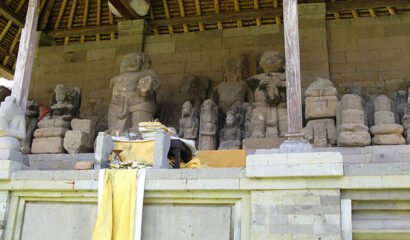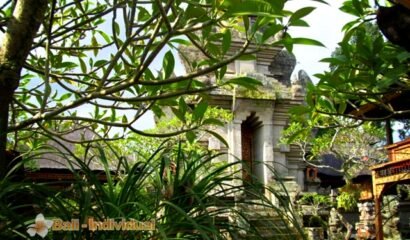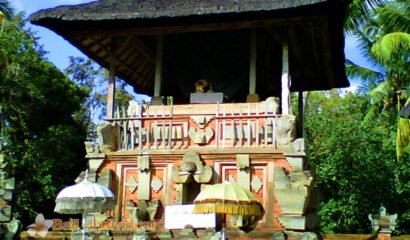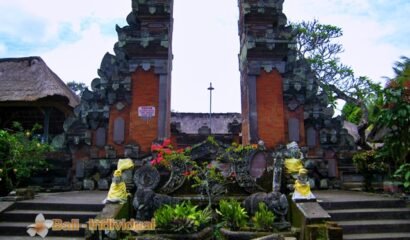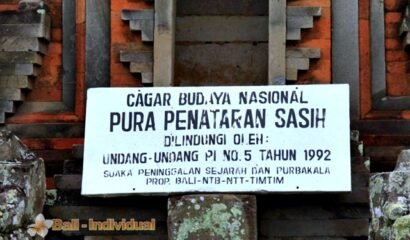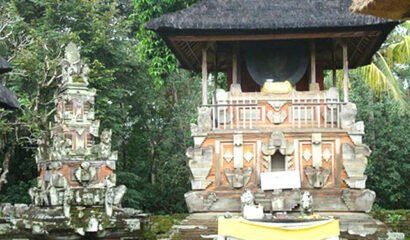In Pejeng, there are literally hundreds of old shrines and sacred spring to visit, and probably hundreds more waiting to be discovered. Some of the more interesting (and accessible) ones are mentioned below.
One of the most impressive antiquities in this area – and in all of Indonesia for that matter – is the “Moon of Pejeng” in the Pura Penataran Sasih (to the right off the main road from Bedulu). Actually a large (186.5 c/73.4 inch high) bronze kettle drum, it dates back to the Bronze Age in Indonesia, which began in 300 B.C. It is the largest drum in the world to be cast as a single piece. Shaped like an hour glass, the kettle drum is of a rare type decorated with eight stylized heads.
Decoration on both the head and body suggest that this kettle drum had its origins in Northern Vietnam (Tonkin), dating back to Dongson times. The Chinese rulers of Tonkin attempted a takeover of Vietnam in the early centuries which led to indigenous revolts. It is theorized that the Tonkin aristocrats who escaped fled to Southeast Asia and brought with them, among other things, then kettle drums.
History
Why does this artifact carry the name Moon of Pejeng? Legend states that the drum used to be a wheel of the chariot which drives the moon on its nocturnal journey through the sky. This illuminated wheel fell from the heavens and landed in a tree near the Penataran Sasih temple, where it has been housed since its “fall’. One night, a thief broke into the temple and was annoyed at the brilliant light which revealed his deeds.
So he climbed a tree and urinated on it, the man lost his life. Since then, no one has dared touch the drum and it is kept locked up in this temple and given daily offerings. This temple was the main religious center of the old Pejeng kingdom and therefore Balinese from all over the island make pilgrimages here.
The Temples
The Pura Arjuna Metapa (”Temple where Arjuna meditated”) is just south of the Pura Pusering Jagat (”Temple of the navel of the world”). Arjuna is an epic hero throughout South and Southeast Asia and a warrior supreme. In this story, Arjuna is mediating in a mountain top, gathering up his energies for an upcoming battle with the evil demon Niwata Kawaca. Pictured here with this divine hero are two attendants Tualen and Merdah, his trusted servants who never leave his side. The gods test Arjuna’s power of concentration by sending down two celestial dedari s or nymphs to rouse him out of his ascetic state. But Arjuna is not disturbed by the celestial beauties and passes the Gods’ test, marrying the dedari in heaven after he defeats the ogre king.
In the Pura Pusering Jagat, we also find dancing figures called catuhkaya (statues carved with a pigure on all four sides). Like the Pejeng Giant, these are demonic with large open eyes and sneering mouths. The “Pejeng Vessel”, also called Naragiri or “Mountain of Man”, is a remarkable cylindrical vessel which represent the “churning of the ocean” when the gods produced the elixir of immortality from the bottom of the sea.
Pura Kebo Edan (”Temple of the Mad Bull”) is in the rice fields south of Intaran. Take the first left off the main road after you arrive in Pejeng. On this site is a gigantic statue over 3 m (11 ft) high, locally called the “Pejeng Giant“. Restored in 1952, this giant is a male figure in a dance posture standing on a wide-eyed human (perhaps a corpse). A stone mask covers his face, which curiously has no face of its own; only abstract designs, horns and fangs. Scholar says that this giant symbolizes Bhairava, a Tantric Buddhist manifestation of the Hindu god Siwa. Bhairava adherents worship Siwa-Bhairava and his wife Durga in their more terrible aspects. A new style of sculpture, showing the demonic in fantastic representations, apparently began with the pieces in this temple and marks the influence the magic Tantic cults.


